tow CHRYSLER CROSSFIRE 2007 1.G Owner's Guide
[x] Cancel search | Manufacturer: CHRYSLER, Model Year: 2007, Model line: CROSSFIRE, Model: CHRYSLER CROSSFIRE 2007 1.GPages: 299, PDF Size: 8.26 MB
Page 208 of 299

Towing Eyes
The vehicle is equipped with front and rear towing eyes
to allow towing with the wheels on the ground or to
allow the vehicle to be easily drawn up on a flatbed tow
truck. The rear towing eye is located on the right side of
the vehicle below the rear fascia. The front hook is
located behind the lower grille in the fascia. For access, a
snap-in grille must be removed using the multifunction
tool from the glovebox.
208 WHAT TO DO IN EMERGENCIES
Page 209 of 299
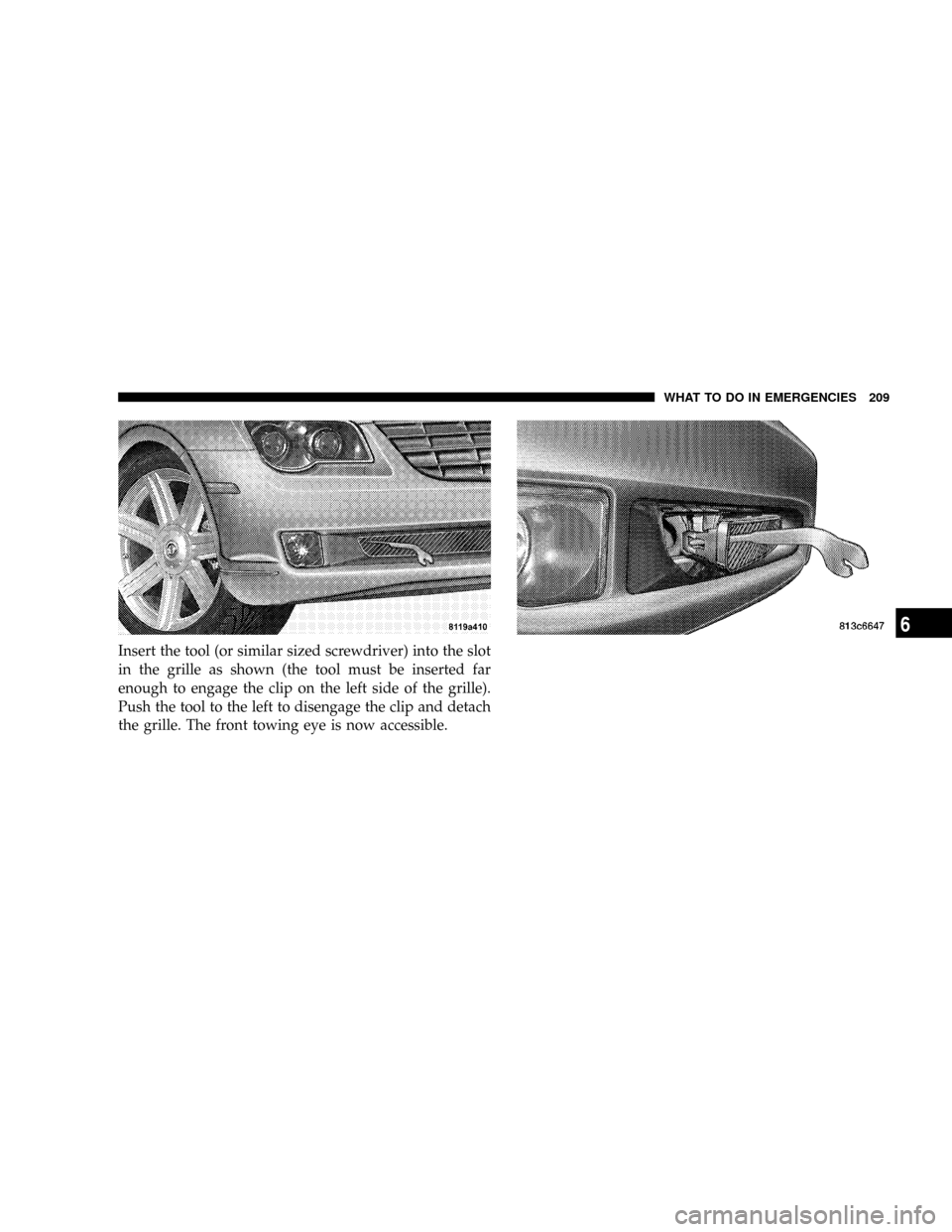
Insert the tool (or similar sized screwdriver) into the slot
in the grille as shown (the tool must be inserted far
enough to engage the clip on the left side of the grille).
Push the tool to the left to disengage the clip and detach
the grille. The front towing eye is now accessible.
WHAT TO DO IN EMERGENCIES 209
6
Page 210 of 299

Tow-Away Alarm
Once the alarm system has been armed, the exterior
vehicle lights will flash and an alarm will sound when
anyone attempts to raise the vehicle for towing. The
alarm will last approximately three minutes in the form
of flashing exterior lights. At the same time, an alarm will
sound for 30 seconds. The alarm will stay on even if the
vehicle is immediately lowered. To cancel the alarm,
insert the key in the ignition switch or press the transmit
button on the key fob.To prevent triggering the tow-away alarm feature, press
the tow-away alarm switch to turn off the tow-away
alarm before towing the vehicle, or when parking on a
surface subject to movement, such as a ferry or auto train.
To do so, turn the key in the ignition switch to the
OFF/LOCK or ACC positions, or remove key from the
ignition switch. Press the upper half of the tow-away
alarm switch. The indicator light will illuminate briefly.
Then, exit the vehicle and lock with a key or the remote
control. The tow-away alarm remains switched off until
the vehicle is locked again with a key or the remote
control, at which time it is automatically reactivated.
210 WHAT TO DO IN EMERGENCIES
Page 214 of 299
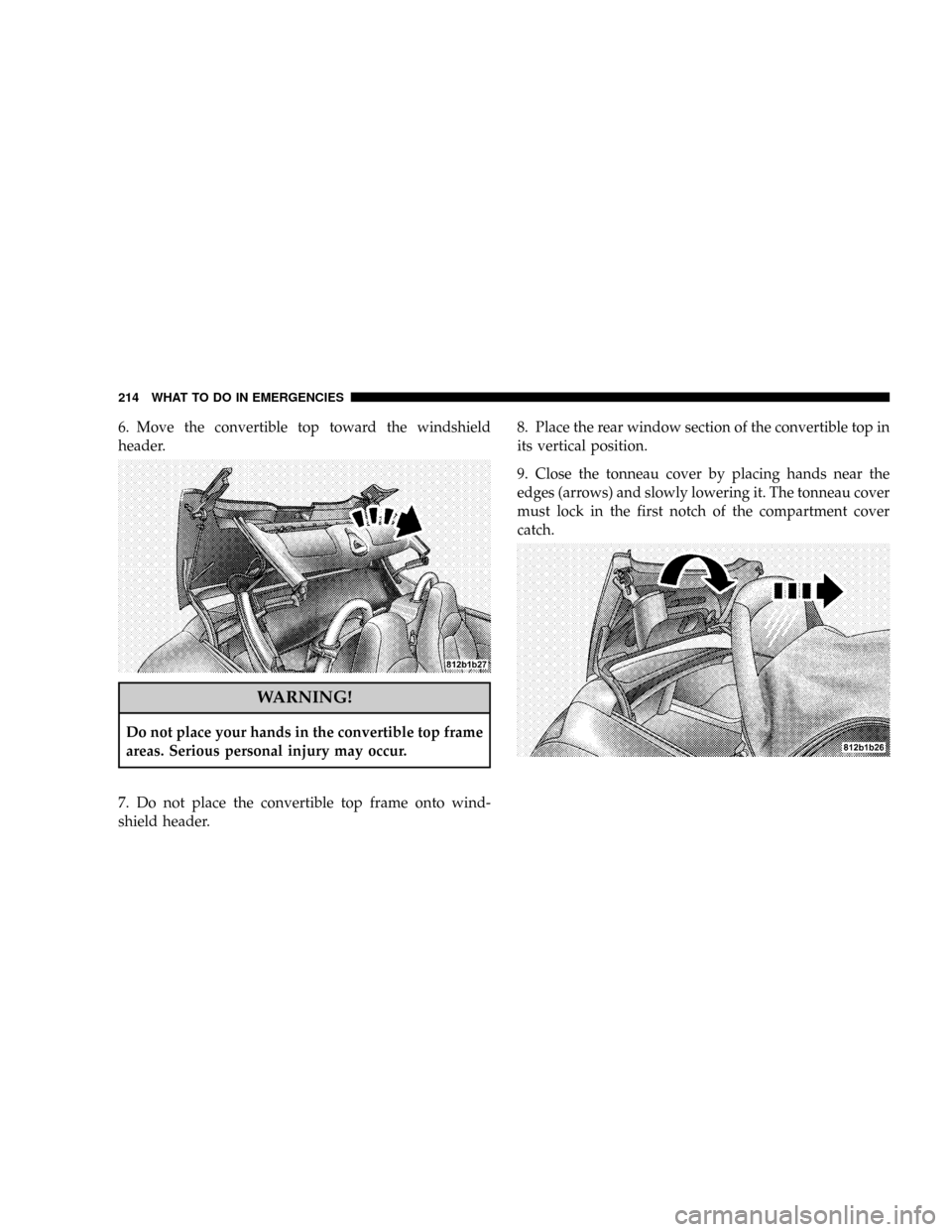
6. Move the convertible top toward the windshield
header.
WARNING!
Do not place your hands in the convertible top frame
areas. Serious personal injury may occur.
7. Do not place the convertible top frame onto wind-
shield header.8. Place the rear window section of the convertible top in
its vertical position.
9. Close the tonneau cover by placing hands near the
edges (arrows) and slowly lowering it. The tonneau cover
must lock in the first notch of the compartment cover
catch.
214 WHAT TO DO IN EMERGENCIES
Page 222 of 299

ONBOARD DIAGNOSTIC SYSTEM (OBD II)
To meet new government regulations and promote
cleaner air, your Crossfire is equipped with a sophisti-
cated onboard diagnostic system called OBD II. This
system monitors the performance of the emissions and
engine control systems. When these systems are operat-
ing properly, your vehicle will provide excellent perfor-
mance and fuel economy, as well as engine emissions
well within current government regulations.
If any of these systems require service, the OBD II system
will turn on the CHECK ENGINE Light. It will also store
diagnostic codes and other information to assist your
service technician in making repairs. Although your
vehicle will usually be drivable and not need towing, see
your authorized dealer for service as soon as possible.CAUTION!
Prolonged driving with the CHECK ENGINE light
on could cause further damage to the emission con-
trol system. It could also affect fuel economy and
drivability. The vehicle must be serviced before any
state emissions tests can be performed.
If the CHECK ENGINE light is flashing, severe catalytic
converter damage and power loss will soon occur. Im-
mediate service is required.
If the gas cap is not tightened properly, the CHECK
ENGINE light may come on. Be sure the gas cap is
tightened every time you add fuel. Tighten the cap until
you hear it ªclickº once.
222 MAINTAINING YOUR VEHICLE
Page 231 of 299
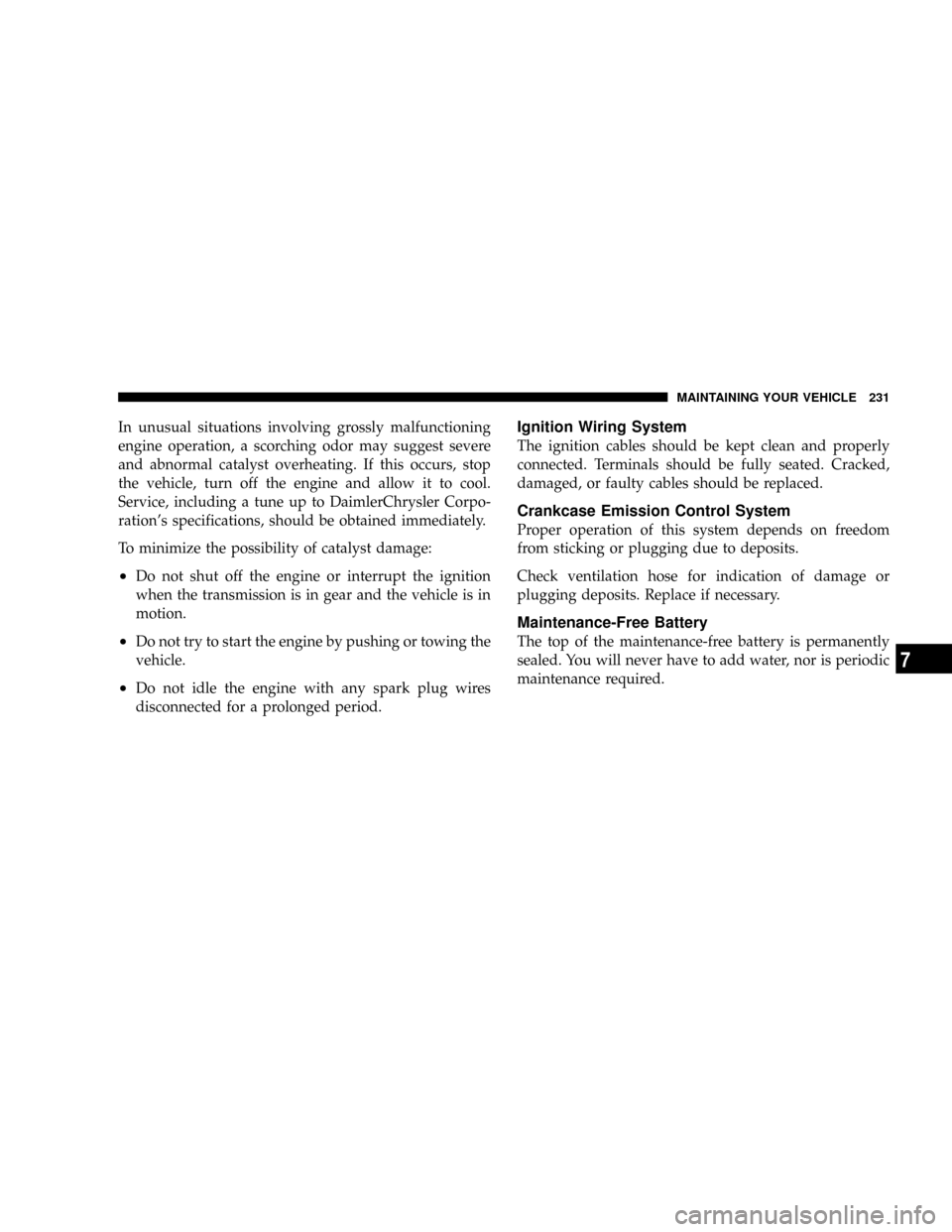
In unusual situations involving grossly malfunctioning
engine operation, a scorching odor may suggest severe
and abnormal catalyst overheating. If this occurs, stop
the vehicle, turn off the engine and allow it to cool.
Service, including a tune up to DaimlerChrysler Corpo-
ration's specifications, should be obtained immediately.
To minimize the possibility of catalyst damage:
²Do not shut off the engine or interrupt the ignition
when the transmission is in gear and the vehicle is in
motion.
²Do not try to start the engine by pushing or towing the
vehicle.
²Do not idle the engine with any spark plug wires
disconnected for a prolonged period.
Ignition Wiring System
The ignition cables should be kept clean and properly
connected. Terminals should be fully seated. Cracked,
damaged, or faulty cables should be replaced.
Crankcase Emission Control System
Proper operation of this system depends on freedom
from sticking or plugging due to deposits.
Check ventilation hose for indication of damage or
plugging deposits. Replace if necessary.
Maintenance-Free Battery
The top of the maintenance-free battery is permanently
sealed. You will never have to add water, nor is periodic
maintenance required.
MAINTAINING YOUR VEHICLE 231
7
Page 292 of 299

Defroster, Windshield..................... 56
Disposal
Engine Oil.......................... 228
Door Locks, Automatic................... 13
Drive Belts............................ 229
Drive Shaft Universal Joints............... 234
Driving
On Slippery Surfaces.................. 205
Electronic Speed Control (Cruise Control)..... 102
Electronic Stability Program (ESP)........... 99
Emergency, In Case of
Hazard Warning Flasher................ 194
Jump Starting........................ 203
Overheating......................... 194
Towing............................. 206
Emergency Trunk Release................. 20
Emission Control System Maintenance....223,273
Engine
Break-In Recommendations............... 55
Checking Oil Level.................... 225
Compartment........................ 221
Oil .............................225,267Oil Change Interval................... 227
Oil Selection......................... 228
Exhaust Gas Caution..................... 55
Exhaust System........................ 237
Exterior Lights......................... 259
Filters
Air Cleaner.......................... 229
Air Conditioning..................... 280
Engine Fuel......................... 229
Engine Oil.......................... 228
Fluid Capacities.....................265,267
Fluid Leaks............................ 57
Fluid Level Checks
Manual Transmission.................. 245
Fluids, Lubricants and Genuine Parts........ 268
Four-Way Hazard Flasher................. 194
Freeing A Stuck Vehicle.................. 206
Fuel................................. 186
Adding............................. 189
Additives........................... 188
Filler Cap (Gas Cap)................... 189
Filter.............................. 229
292 INDEX
Page 297 of 299
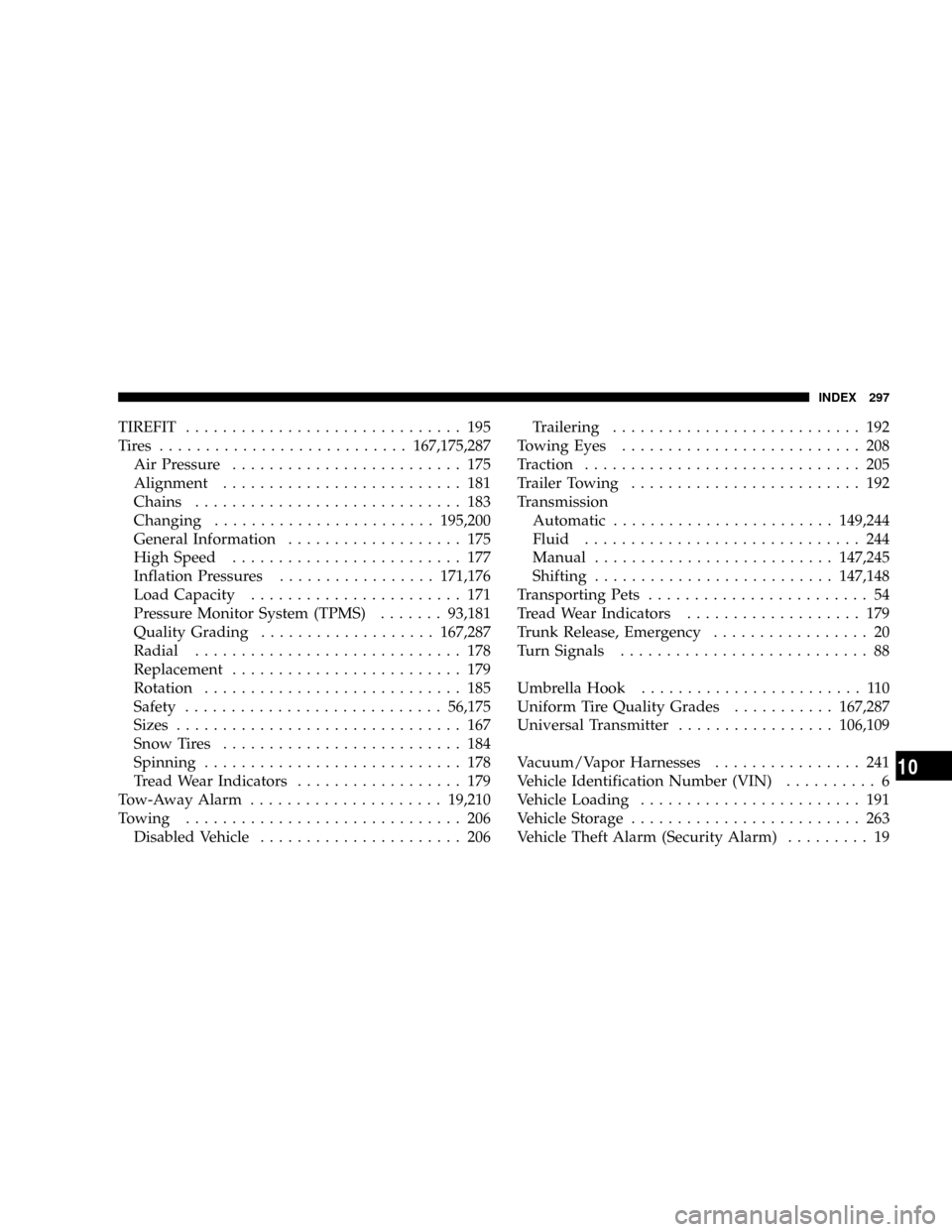
TIREFIT.............................. 195
Tires ...........................167,175,287
Air Pressure......................... 175
Alignment.......................... 181
Chains............................. 183
Changing........................195,200
General Information................... 175
High Speed......................... 177
Inflation Pressures.................171,176
Load Capacity....................... 171
Pressure Monitor System (TPMS).......93,181
Quality Grading...................167,287
Radial............................. 178
Replacement......................... 179
Rotation............................ 185
Safety............................56,175
Sizes............................... 167
Snow Tires.......................... 184
Spinning............................ 178
Tread Wear Indicators.................. 179
Tow-Away Alarm.....................19,210
Towing.............................. 206
Disabled Vehicle...................... 206Trailering........................... 192
Towing Eyes.......................... 208
Traction.............................. 205
Trailer Towing......................... 192
Transmission
Automatic........................149,244
Fluid.............................. 244
Manual..........................147,245
Shifting..........................147,148
Transporting Pets........................ 54
Tread Wear Indicators................... 179
Trunk Release, Emergency................. 20
Turn Signals........................... 88
Umbrella Hook........................ 110
Uniform Tire Quality Grades...........167,287
Universal Transmitter.................106,109
Vacuum/Vapor Harnesses................ 241
Vehicle Identification Number (VIN).......... 6
Vehicle Loading........................ 191
Vehicle Storage......................... 263
Vehicle Theft Alarm (Security Alarm)......... 19
INDEX 297
10
Page 299 of 299
INTRODUCTION INTRODUCTION HOW TO USE THIS MANUAL WARNINGS AND CAUTIONS VEHICLE IDENTIFICATION NUMBER THINGS TO KNOW BEFORE STARTING YOUR VEHICLE A WORD ABOUT YOUR KEYS KeysObtaining Replacement KeysIgnition
Key RemovalKey-In-Ignition ReminderGLOVE COMPARTMENT LOCK DOOR LOCKS Central Locking SwitchAutomatic Central LockingGeneral Notes On the Central Locking SystemEmergency Unlocking FeatureStart LockoutREMOTE KEYLESS ENTRY To Unlock the
DoorsTo Lock The DoorsPanic AlarmTo Use the Panic AlarmGeneral InformationTransmitter Battery ServiceSECURITY ALARM SYSTEM Tow-Away AlarmDECKLID INTERNAL EMERGENCY RELEASE - ROADSTER POWER WINDOWS Power Window Operation With
The Convertible Top Switch (Roadster Only)REAR LIFTGATE/DECKLID RELEASE OCCUPANT RESTRAINTS Lap/Shoulder BeltsSeat Belts and Pregnant WomenSeat Belt ExtenderSupplemental Restraint System (SRS) - Airbag Child RestraintENGINE BREAK-IN
RECOMMENDATIONS SAFETY TIPS Exhaust GasSafety Checks You Should Make Inside the VehiclePeriodic Safety Checks You Should Make Outside the VehicleUNDERSTANDING THE FEATURES OF YOUR VEHICLE CONVERTIBLE TOP OPERATION To Lower
The TopTo Raise The TopConvertible Top Lamp and Audible Signal ChartCONSOLE FEATURES Storage Compartments (If Equipped)AshtrayCoin HolderPower Outlet/Cigar LighterGlove CompartmentCUPHOLDER (If Equipped) MIRRORS Inside Day/Night MirrorExterior
Mirrors Folding FeatureHeated Remote Control Mirrors (If Equipped)Outside MirrorsPower Remote Control Outside MirrorsVanity Mirrors SEATS Manual Seat Adjustments (If Equipped)Driver Eight-Way Power Seat (If Equipped)Passenger Four-Way Power Seat (If Equipped)
Heated Seats (If Equipped)TO OPEN AND CLOSE THE HOOD INTERIOR LIGHTS Front Map/Reading LightsBattery Saver FeatureInstrument Panel LightingNightSecurity IlluminationEXTERIOR LIGHTS Headlights and Parking LightsDaytime Running Lights (Where
Applicable)Fog Lights (If Equipped)Standing LightsMULTIFUNCTION CONTROL LEVER Turn SignalsHeadlight Dimmer SwitchPassing LightWindshield Wipers And WasherMist FunctionTELESCOPING STEERING COLUMN TIRE PRESSURE MONITOR SYSTEM (if
equipped) REAR SPOILER BRAKE ASSIST SYSTEM (BAS) ELECTRONIC STABILITY PROGRAM (ESP) Synchronizing ESPELECTRONIC SPEED CONTROL To Vary The Speed SettingTo DeactivateTo Resume SpeedUsing Speed Control On HillsGARAGE DOOR
OPENER (If Equipped) Programming The Universal TransceiverGate Operator/Canadian ProgrammingUsing the Universal TransceiverErasing Universal Transceiver ButtonsReprogramming a Single ButtonSecurityUMBRELLA HOOK UNDERSTANDING YOUR
INSTRUMENT PANEL INSTRUMENTS AND CONTROLS INSTRUMENT CLUSTER INSTRUMENT CLUSTER DESCRIPTION INFINITY MODULUS AM/FM STEREO RADIO WITH SINGLE-DISC CD PLAYER AND GPS NAVIGATION AM/FM STEREO RADIO WITH
SINGLE-DISC CD PLAYER INFINITY MODULUS Entertainment SystemsCD Player OperationUser MenuUser Memory (USER - 1, 2, 3)Mono/StereoDriver - L/RTelephone mute characteristicsCOMPACT DISC MAINTENANCE RADIO ANTENNA RADIO OPERATION AND
CELLULAR PHONES CLIMATE CONTROLS Temperature ControlFan ControlBasic Setting - HeaterBasic Setting - Air ConditionerDust Filter (If Equipped)Operating Tips STARTING AND OPERATING STARTING PROCEDURES Normal StartingExtremely Cold Weather
(below -20 degrees F or -29 degrees C)If Engine Fails to StartAfter StartingTRANSMISSION SHIFTING Manual Transmission Recommended Shift SpeedsAutomatic Transmission StoppingManeuveringPark PositionReverseNeutralDriveAutoStick Gear selectionGear Ranges
Program mode selector switchEmergency Operation (Limp Home Mode)PARKING BRAKE BRAKE SYSTEM Brake Assist System (BAS)Electronic Stability Program (ESP)Synchronizing ESPESP Control switchAnti-Lock Brake System (ABS)Brake Pad Break-InPOWER
STEERING TIRE SAFETY INFORMATION Tire Markings Tire Identification Number (TIN)Tire Loading and Tire PressureTIRES-GENERAL INFORMATION Tire PressureTire Inflation PressuresRadial-Ply TiresTire SpinningTread Wear IndicatorsReplacement TiresAlignment
And BalanceTIRE PRESSURE MONITOR SYSTEM (If Equipped) General InformationTIRE CHAINS ORIGINAL EQUIPMENT TIRES SNOW TIRES TIRE ROTATION RECOMMENDATIONS FUEL REQUIREMENTS Reformulated GasolineGasoline/Oxygenate BlendsMMT
in GasolineMaterials Added to FuelSulfur in GasolineADDING FUEL Fuel Filler Cap (Gas Cap)VEHICLE LOADING Roof Luggage RackTRAILER TOWING WHAT TO DOIN EMERGENCIES HAZARD WARNING FLASHER IF YOUR ENGINE OVERHEATS TIREFIT TIRE
REPAIR AND JACKING TIREFITPreparations for JackingJack Location and Instructions JUMP-STARTING THE BATTERY DRIVING ON SLIPPERY SURFACES Traction FREEING A STUCK VEHICLE TOWING A DISABLED VEHICLE Towing EyesTow-Away Alarm
CONVERTIBLE TOP EMERGENCY OPERATION Relieving Hydraulic PressureOpening a Locked DecklidMAINTAINING YOUR VEHICLE 3.2L ENGINE ONBOARD DIAGNOSTIC SYSTEM (OBD II) EMISSIONS INSPECTION AND MAINTENANCE PROGRAMS
REPLACEMENT PARTS DEALER SERVICE MAINTENANCE PROCEDURES Engine OilIgnition Wiring SystemCrankcase Emission Control SystemMaintenance-Free BatteryAir ConditionerPower Steering FluidChassis LubricationBody LubricationWindshield Wiper Blades
Windshield Wiper Blade ReplacementWindshield Washer ReservoirExhaust SystemCooling SystemHoses And Vacuum/Vapor HarnessesBrakesAutomatic TransmissionManual TransmissionAppearance Care and Protection from CorrosionCONVERTIBLE TOP CARE
WashingGeneral CleaningWeather Strip CareFUSES Underhood Accessory Fuse Block FusesRelay Control Module Fuses Interior Fuses REPLACEMENT BULBSInterior Light BulbsExterior Light BulbsEXTERIOR LIGHT BULB SERVICE HeadlightsFront Turn Signal and
Parking/Standing LightsFront and Rear Sidemarker LightsTail, Stop, Back Up and Turn Signal LightsLicense Plate LightHeadlight AimingVEHICLE STORAGE SPECIFICATIONS FLUID CAPACITIES RECOMMENDED FLUIDS, LUBRICANTS AND GENUINE PARTS Engine
ChassisBodyMAINTENANCE SCHEDULES INTRODUCTION WARRANTY EMISSION CONTROL SYSTEM MAINTENANCE MAINTENANCE SCHEDULES SCOPE OF WORK FOR A SCHEDULE MAINTENANCE SERVICESCOPE OF WORK FOR B SCHEDULE
MAINTENANCE SERVICEFSS SYSTEM REGULAR CHECK-UPS Additional Periodic MaintenanceSPECIAL MAINTENANCE REQUIREMENTS CoolantDust Filter for Heating/Ventilation Replacement (If Equipped)ENGINE OIL CHANGE AND FILTER REPLACEMENT IF
YOU NEED CONSUMER ASSISTANCE SUGGESTIONS FOR OBTAINING SERVICE FOR YOUR VEHICLE Prepare For The AppointmentPrepare A ListBe Reasonable With RequestsIF YOU NEED ASSISTANCE WARRANTY INFORMATION MOPAR PARTS REPORTING
SAFETY DEFECTS In CanadaPUBLICATION ORDER FORMS DEPARTMENT OF TRANSPORTATION UNIFORM TIRE QUALITY GRADES TreadwearTraction GradesTemperature GradesINDEX